July 15 – August 10, 2019
The month-long journey from Halifax, Nova Scotia to Traverse City, MI has come to its end, and we are looking forward to some time in dry dock. Praise God for the extraordinary weather we have experienced on our trips— like San Diego every day–cool and dry! And we appreciate the amazing grace of travel where we arrived with our luggage at every stop on time. We just had to share the nightmare of canceled flights and lost luggage that our friend Sue Kirkland lived over five days to realize that none of this should be taken for granted. The three days in the midst of travel at the Summer Seminar for Women at Camp Miniwanca (Michigan) were satisfying for Sue, so it was not all anxiety and anguish.
On our Road Scholar Tour (guided masterfully by Tammy Pickering), we learned about historically unnoticed people who made significant contributions. It was a lesson in the beauty and magnanimity of lives lived without fanfare, but lived with joy and dedication. Artists and inventors, who followed their callings and spoke from their hearts for reasons they could not explain.
New meaning for the vocation “hooker” was discovered in Cheticamp, Nova Scotia. Elizabeth LeFort, a local rug hooker in large canvases, displayed her work all over the world, including the Vatican, Buckingham Palace, the White House and at the Museum of Civilization in Ottawa. The labor that goes into some of her work can hardly be imagined.
“The turning point of the rug industry came when in 1927, Lillian Burke, an artist from New York as well as a friend of the (Alexander Graham) Bell family of Baddeck, visited this area. She became interested in these works of art which she introduced on the U.S. market” [heticampns.com/2015/08/04/rug-hooking/]. She was a mixed blessing, placing Cheticamp on the map of hooking artisans, while pressing the local women to hard labor, according to her exacting standards.
In this historical turn we measure the price of fame. In obscurity the beauty was just as real, yet the beauty might have been lost to history without the crass invasion of the mass production motive of Lillian Burke. Below a crucifixion scene, an easily 3′ x 6′ canvas of hooked yarn. Amazing detail for the medium!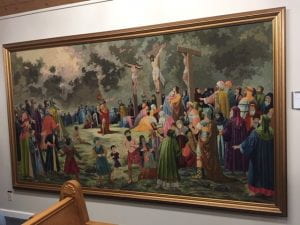
“In the afternoon we stopped at the Alexander Graham Bell Historic Site, an eye-opening display of one man’s genius and humanitarian spirit. Bell was a chronic dreamer and inventor. Early in his career he worked on a system for teaching the deaf, which brought him to the Boston School for the Deaf in 1877, a mile from our (Kathy’s and my) first home in Randolph, MA.” [https://wtucker.edublogs.org/2019/07/19/scotia-scholars-on-the-road/]
Below with Helen Keller, left, and her teacher, Anne Sullivan.
In Bell I recognized the restless spirit of invention and creativity, and yet his earliest impulses were humanitarian, the education of the deaf. His desire to retreat to the obscure, but lovely village of Baddeck, Cape Breton was in conflict with his desire to collaborate with the greatest aeronautic inventors in the world to develop advanced versions of the Wright Brothers’ contributions. He managed to gather his colleagues to Cape Breton to demonstrate later prototypes of flying machines. He had an ample estate capable of entertaining inventors in style.
We spent time in Prince Edward Island chiefly to pay tribute to the industry of Anne of Green Gables, which had put PEI on the map. But we met other less famous historical characters, who were no less inspiring. On the Seventh Day, we awoke to a whimsical historical lecture by Cameron McDonald beginning inside the hotel and continuing to walk the streets of Charlottetown, PEI.
At a present-day playground and location of a nineteenth century scaffold, Cameron recounted the hanging of George Dowie, a sailor who lived with a “female acquaintance,” who became the object of a barroom brawl and murder. All appeals for clemency were promptly refused by the Colonial Office. And so, on April 6, 1869, George Dowie was sentenced to meet his fate. https://everything2.com/title/The+Hanging+of+George+Dowie. The story is full of drama and pathos, as George Dowie prevented a riot for his defense by silencing the mob and letting his execution go forward. Dowie was granted a last statement, according to tradition. As it was eight pages of small handwriting, accompanied by an additional seventeen-stanza poem dedicated to his mother and wife, the authorities provided him with a chair from which to read. Apparently, he had experienced a religious conversion, and proceeded to confess his past sins and his new devotion to Christ. His primary message was one of warning to others to shun “drink, vicious inclinations, evil habits, and dens of iniquity.” The reading took half an hour. There was also a moment where he thanked the Clergymen who were present to pray for him, the lawyers who had worked for him, and confessed that he had no hard feelings towards the executioner.
Dowie was truly a reformed drunkard. His story re-fueled my interest in prison reform, both social and personal. The drama behind the walls is not always violent, it is often transformational.
The life of the author L.M. Montgomery was more fascinating to me than the exploits of Anne of Green Gables. Montgomery had a compulsion to write and kept voluminous journals besides her widely published short stories and poems. Yet she notes in the excerpt below that she suffered bouts of depression and associated them with the burden of creativity. She says “They give us sensitivity to beauty in all of us, but the shadow of the gift goes with it.” She echoes the historical record of the many writers and other artists who struggled with depression. Is there a price to pay for extraordinary creativity? I have often wondered.
In Canada I learned that everything American is not admired– especially our glorious American Revolution. The Canadians resolved their dependency on Great Britain with civilized negotiation in 1864, nearly a century after the American Revolution. To them, the Revolution was a more radical solution with some trampling on the rights of the people who later came to settle Canada in the late 1700’s. As Will Ferguson writes in his mildly satirical essays, Why I Hate Canadians,
The Patriots trampled on the very human rights they purported to be defending: they took hostages, they seized and opened mail, they staged violent boycotts, they orchestrated kangaroo courts, and they held what can only be dubbed as “consciousness-raising” sessions, where people suspected of being loyal to Britain were badgered into swearing allegiance to the revolution. The Patriots also confiscated and auctioned off the land and property of suspected “traitors (96).
I was awakened to the seamy side of American history by some of Ferguson’s documented essays, as well as by our recent attending of the performance of 1776 in St. Louis is June. The process of making the sausage of Independence is often more unprincipled than our history books admit.
One of the highlights of our trip was witnessing the tides of the Bay of Fundy. At Hopewell Rocks we saw the ravages of the tide in the gigantic rock formations visible at low tide. We had been invited to “walk the ocean floor,” the bottom vacated by the receding tide, which could rise over 50 feet above the low tide level. But the drama was best witnessed in the rising tide.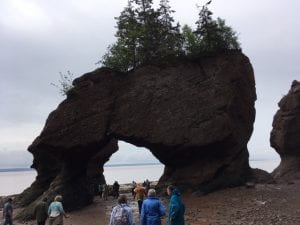
“The tide visibly surges twice in 24 hours at the channel running through Moncton, Nova Scotia. When we stayed at the Rodd Moncton the night before, we were told we could observe the high tide cresting as it came up the channel at approximately 2:45 a.m., so we had a dilemma: a good night’s sleep or to witness a “tidal bore.” We decided to get out of bed at 2:30, since the channel was steps from our hotel door. There was partial streetlight shining on the channel when we staggered out to the observation platform.
Sure enough, around 2:37 we could hear a rushing sound around the bend and presently a small breaker rounded the corner and crawled in our direction. The cresting foam was barely high enough to notice, but it approached like a living thing let out of its confinement. If there is such a feeling as ‘slightly awed,’ I felt it. It rolled by our eyes and upstream into the night.” [https://wtucker.edublogs.org/2019/07/28/green-gables-inc/]
Lunenburg, Nova Scotia was certainly the most scenic of the villages we visited. “In 1995 the United Nations designated Lunenburg a World Heritage site for its unique preservation of the British Colonial layout and authenticity as a working town. There are only three such sites in North America.” [Lunenburg: A Visitors’ Guide, 2019]
During the eighteenth century the British and French vied for control of the Canadian Maritimes. Lunenburg was settled by Germans, Swiss, and French (1753) as part of Britain’s attempt to establish a fortress against the French, who were fortified at Louisbourg (an actual fortress we visited earlier). Below a view of the four prominent churches of the skyline, including Zion Lutheran, St. John’s Anglican (1754), Central United Church, and St. Andrews Presbyterian (barely visible).
Like Halifax, up the coast, Lunenburg suffered a devastating waterfront fire that wiped out a stretch of history, but the citizens rallied to recover their waterfront with lovely Victorian buildings. For some reason the diversity of cultures and religions in Lunenburg’s history has made their people most conscious of historical preservation. Lunenburg Academy kept its place on the hill overlooking the town through fire and internal changes that transformed it into a private school for musicians and sailors.
We discovered the contemporary folk artist Maud Lewis, a national treasure, who suffered from childhood rheumatoid arthritis. Each of her paintings was a suffering passion, as you can see from the video, which corresponds with documentary video we saw in the museum. If anything, her husband was more cruel than the independent movie “Maudie” allows him to be.
[ https://www.youtube.com/watch?v=wCZ_guQTGNw]
“Maudie” is the essence of the artist struggling through pain, both physical and emotional. The incandescence of her spirit as viewed in her art amazes and awes me. She made her very humble and austere life beautiful by her painting and has inspired me to compose under all circumstances. Like other creators — Elizabeth LeFort and Alexander Graham Bell, she was more dedicated to her art than any need for fame, and yet the fame came without invitation.
Our week between trips was spent with Bill and Wizzy at home and Victoria at the Miniwanca Summer Seminar for Women [https://ayf.com/camps/miniwanca/summer-seminars-women/]. Victoria attended her eighth Summer Seminar.
A Sunday (8/4) midnight flight brought me to Grand Rapids, where Victoria and I met up following the Summer Seminars for Women at Camp Miniwanca (Shelby, MI). We had breakfast at Anna’s, where I captured a one-of-a-kind display of electric toasters (left). Someday kids will point to that and say, “What are those things?”
In Traverse City, we were the royal guests of the Standfest Dynasty, specifically Kathleen (Victoria’s sister) and Gordie. They are pictured below in their native habitats, Sleeping Bear Dunes and Mari Vineyard. On Wednesday we visited the Music House Museum, a unique collection of mechanized music instruments. “The collection spans from the late 18th century to 1950, going from simple music boxes to early recorded sound and radio ” [http://musichouse.org/]
A unique exhibit is the Weber Duo Art Reproducing Grand Piano, which reproduces the player along with the music with advanced player piano technology. George Gershwin recorded his “Rhapsody in Blue” on this instrument, translating his style, along with the music. As with all of the exhibits, this instrument performed for us with impressive fidelity, translating the dramatic flair of Gershwin at the keyboard.
The history of air-powered musical reproduction is displayed in this extraordinary museum with a 90-minute tour and demonstration of many of the instruments. The tour culminates with a silent short film, featuring a recording of the 1924 Wurlitzer Organ of Detroit Fox Theater fame. Below, three of the impressive variety of air-powered organs.
Gordie and Kathleen honored us with a royal tour of Traverse City, including the boatyard of the Maritime Heritage Alliance [http://www.maritimeheritagealliance.org/], the Music House Museum, the Old Mission Peninsula, and to the west, Sleeping Bear Dunes and Pierce-Stocking Scenic Drive.[https://www.nps.gov/slbe/planyourvisit/psscenicdrive.htm].
On the Old Mission Peninsula we toured Mari Vineyards, with its impressive stone work, executed by Gordie’s firm, Standfest Masonry [see exterior below].
This final leg of our journey was most amazing to me, who had criminally neglected the western side of Michigan during the twenty-five years I lived in the mitten. The beauty of the Grand Traverse region was comparable to most any sight in the Canadian Maritimes, rivaled only by the Bay of Fundy. Grateful for even a three-day immersion in this stunning land-and sea-scape.
Gloria Dei for the characters and scenery that delighted us these last four weeks. We were well-served by the weather reprieve from St. Louis, but more deeply felt the shining beauty of Cape Breton, the stark display of the Bay of Fundy, the joyful harbor of Lunenburg (with a memorable lobster and macaroni at Grand Banker Bar & Grill), and the quiet rush of the tidal bore in Moncton, NB at 2:37 a.m., July 23, 2019. There is more summer to relish in Chesterfield, MO, but we will continue to feed on the movable feast of the Maritimes and Traverse City.

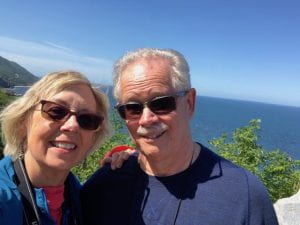
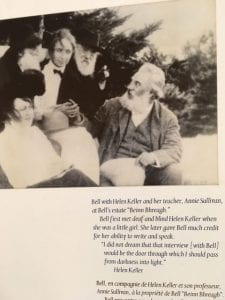

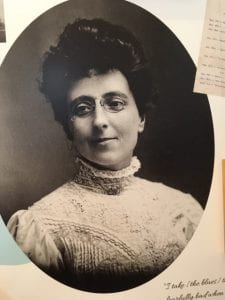
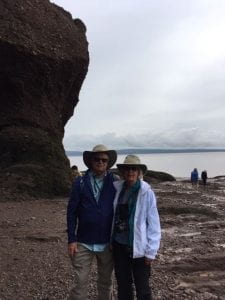

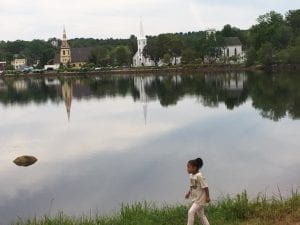
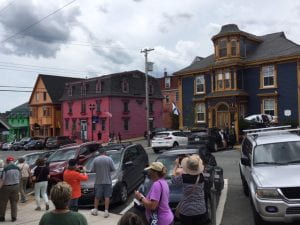
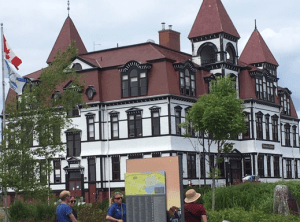
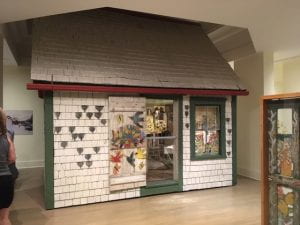
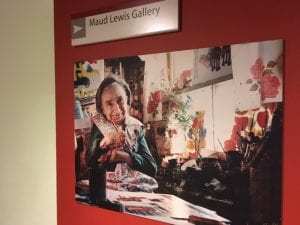
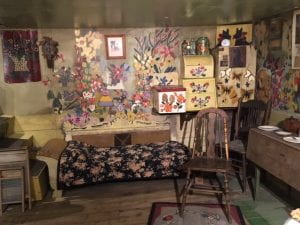
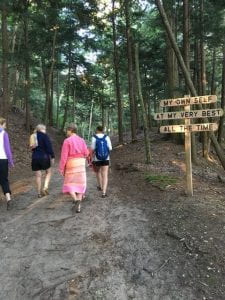
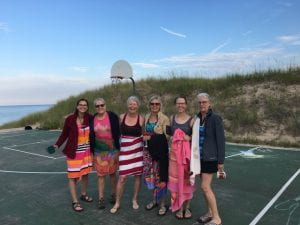
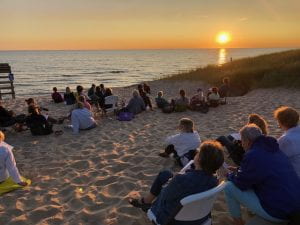




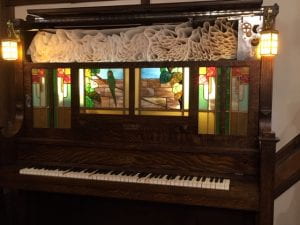
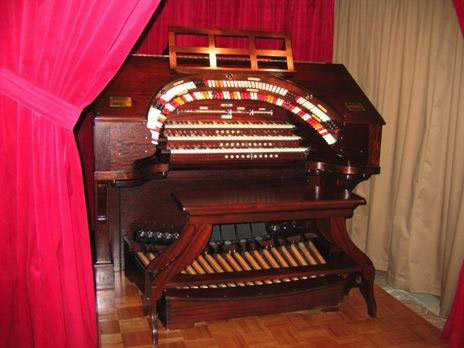
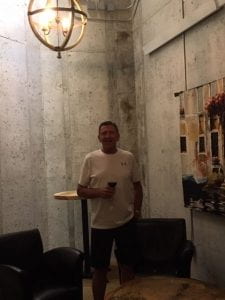
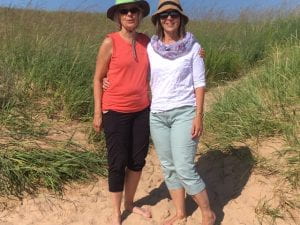
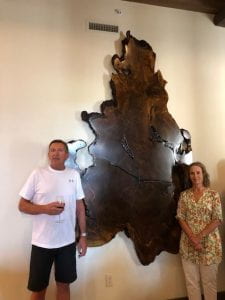
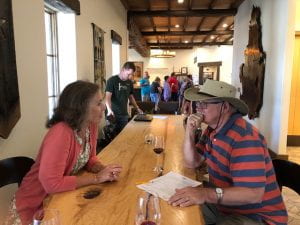
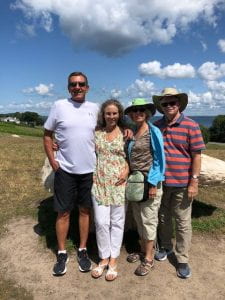
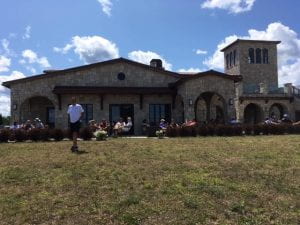

Thanks, Bill, for this moving tribute to so many places of wonder–historical, geographical and even gustatory!
We know the Fundy tidal phenom from where Colin and Jodie live. It is very visible even at that end in Eastport ME and St. Andrews NB.
On our way Sat. to Bar Harbor for a week with all the family–Mt Desert Island in all its glory.
Our best to Victoria and we wish you many more memorable travels like this!
B&J
TRULY BLESSED you are. your sharing is well received.
Thanks for reading, Diane. I hope you are as well as you look on FB. We are indeed blessed and happy, looking for ways we can help as well. One of our causes is Prison Performing Arts, which produces plays with inmates in Missouri prisons. We have been to three of their productions.
Thanks for the affirmations, Beverly. Halifax, Lunenburg, and Perry’s Cove are not too far from New Brunswick. You may know about the Bluenose ferry, which goes from Portland to Halifax. That would be a great trip. Blessings and love to Colin and Jodie.
Grace and love to you and John
Bill & Victoria